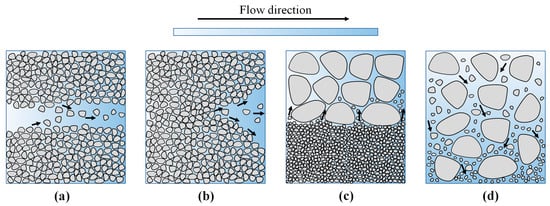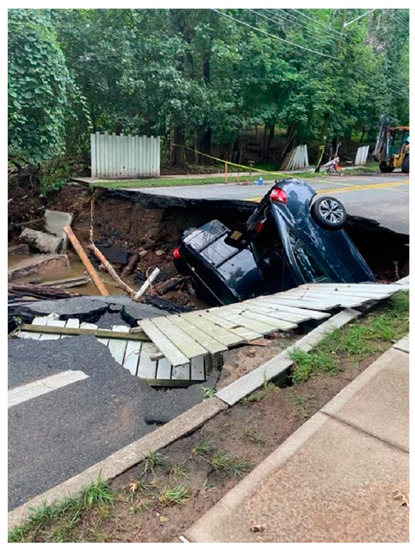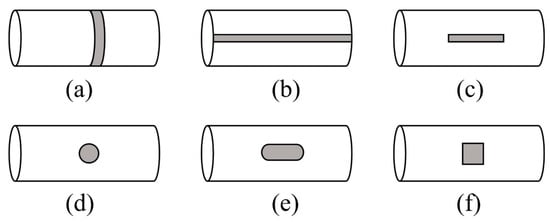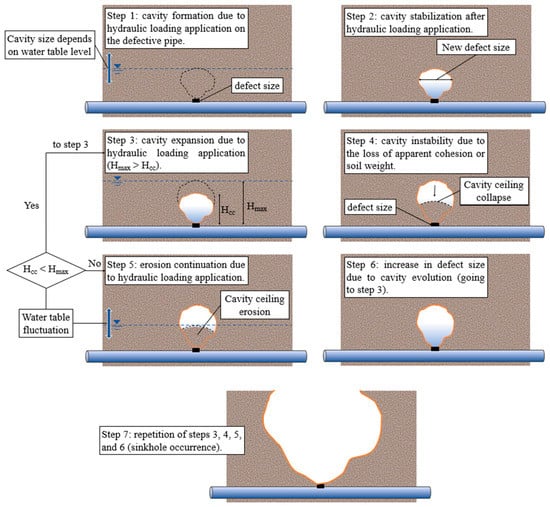Sinkholes are a significant underground hazard that threatens infrastructure and lives and sometimes results in fatalities. The annual cost of sinkhole damages exceeds $300 million, although this estimate is likely underestimated due to the need for national tracking. Sinkholes can also alter natural drainage patterns, leading to increased flood risk. While natural sinkholes occur, those in urban areas are predominantly manmade, caused by soil erosion from defective pipes, typically due to aging. Climate change, storm surges, and urbanization have accelerated subsidence in urban environments, posing greater risks to critical infrastructure and densely populated areas. Extensive research has focused on soil erosion in dams; however, this knowledge does not necessarily apply to erosion through orifices, where gravity and other factors play significant roles.
- internal soil erosion
- sinkhole
- defective pipes
- urban environments
1. Background
1.1. Internal Soil Erosion
1.2. Internal Soil Erosion in Embankment Dams
Internal soil erosion in embankment dams has been extensively researched. Bonelli [14] and Robbins and Griffiths [13] classify internal erosion mechanisms in embankment dams into four groups: (1) concentrated leaks, (2) backward erosion piping, (3) contact erosion, and (4) internal instability, also known as suffusion and suffosion. These mechanisms (see Figure 1) may appear either separately or simultaneously depending on different factors that include the seepage flow direction, soil mass conditions, and soil particle distribution, among others.
1.3. Soil Erosion in Urban Environments
One of the biggest threats stemming from soil erosion in urban environments is the formation of sinkholes. Sinkholes, cavities in the ground, are normally formed either by the dissolution of rock in karst environments or by internal soil erosion. Many researchers have studied the occurrence of sinkholes in karst terrains [6][7][18][19][20][6,7,26,27,28]. Soil erosion through dams is also relatively well understood due to the significant amount of research done in this field, as described in the previous section. However, in urban environments, deteriorating buried pipes are the main cause of SEDP. This type of internal soil erosion is initiated by the existence of defective buried pipes. Once the defect is present, if the water table is above the detective pipe, infiltration takes place, and the SEDP propagates due to the seepage forces induced by hydraulic gradients. As soil erosion progresses, a cavity right above the defect will form, which eventually may cause ground failure, typically causing a sinkhole [21][22][29,30]. This seems to be the most reported mechanism; however, if the defect is present in the lower part of the pipe, and the water table is below the pipe, exfiltration from the fluids inside the pipe may also cause soil erosion, creating a void right underneath the pipe. If it progresses, it may also lead to a collapse. Soil erosion in urban environments can have devastating consequences. Laura [23][31] reports a catastrophic sinkhole with damages of 7.7 million dollars in Tucson, Arizona, in 2002 due to soil erosion due to a broken sewer pipe. Also, in Syracuse, New York, a sinkhole with a diameter of 9 m and depth of 6 m collapsed because of the SEDP after a heavy storm in 2011 [24][32]. More recently 2017, another devastating sinkhole in the size of a football field appeared in Fraser, Michigan, causing 20 houses to sink into it [25][33]. A recent case of a large sinkhole happened in September 2021 near Hoboken in New Jersey, in the aftermath of hurricane Ida. The large sinkhole damaged the road and dragged two vehicles into it (see Figure 2).
2. Soil Erosion Due to Defective Pipes (SEDP): Experimental Studies
According to Kuwano et al. [26][36], embedded pipes may be defected due to several factors, including poor construction, aging process, environmental loads, external loads such as earthquakes and traffic loads, or a combination thereof. Kuwano et al. [26][36] reported that inadequate construction is the main reason for the origin of pipe defects, mainly due to human errors and accidents during construction. Indiketiya [27][35] describes defects in sewer pipes due to the construction of other nearby structures, such as piles, water pipes, and gas pipes. Indiketiya [27][35] stated that most of these defects are caused by human errors that can largely be avoided by proper due diligence during the planning phase of construction projects, which includes a detailed utility investigation. Utility investigations are fundamental in urban environments and densely populated areas with a complex subsurface utility infrastructure network (pipes, conduits, cables). It should include reviewing available public records and utility maps, contacting utility companies directly, when possible, and field inspection for evidence of subsurface utilities. Even though unintentional damage to pipes occurs during the construction of other structures, aging is likely to be the most influential factor causing the defect development in pipes. Pipe deterioration is intrinsically related to the type of pipe material, the environment surrounding the pipe, and the loads the pipe is subjected to during its life cycle. For example, ceramic-made and concrete-made pipes showed the highest deterioration proportion, and sewer pipes’ damage risk considerably increases when the pipe age is higher than 25 years [26][36]. Freeze-thaw cycles are an example of environmental loads which induce pipe defects [28][29][37,38]. Other external loads, such as traffic loads, adjacent construction of buildings, as well as earthquakes, can also cause pipe damage [30][31][39,40].2.1. Hydraulic Conditions
Based on the literature, hydraulic loading conditions are one of the most influential factors in the rate and volume of soil erosion. This makes sense since soil particle displacement initiates by seepage forces induced by a pressure difference resulting from the existence of pipe defect. Several researchers studied the effect of different types of hydraulic loadings on SEDP. Overall, three types of hydraulic conditions were used by different researchers to simulate real-life conditions: 1. monotonic water inflow (exfiltration) to simulate the pipe leakage. 2. monotonic water drainage (infiltration) to simulate leakage from surrounding media into the pipe. 3. infiltration-exfiltration cycles to study the long-term effects of leakage into and from pipes (see Figure 3 for details).
2.2. Pipe Conditions: Pipe Defect and Pipe Depth
2.2.1. Pipe Defect Characteristics

| Researchers | Defect Size (mm) | Defect Shape | Defect Location | Pipe Depth 1 (mm) |
|---|---|---|---|---|
| Mukunoki et al. [32] | 5 × 5; 2.5 × 10; 5 × 50; 5 × 78.5 | Square, rectangle, straight | Top of the pipe, on the circumference of the pipe | 100 |
| Mukunoki et al. [35] | 2.1 and 5 | Straight | on the circumference of the pipe | 100 |
| Guo et al. [36] | 10 and 20 | Circular | Top of the pipe | 100, 200, 300, and 400 |
| Tang et al. [33] | 3 and 9 | Straight | Top, side and horizontal of the pipe | 250 and 300 |
| Indiketiya et al. [37] | 10 × 60; 20 × 60; 30 × 60 | Rectangle | Top of the pipe | 400 |
| Basak and Sarkar [38] | 3 and 5 | Straight | Top, side and horizontal of the pipe | 100 |
| Ali and Choi [39] | - | Artificially created crack with no particular shape or dimensions | Bottom and top | 40 |
| Zhang et al. [34] | 5 and 5 × 10 | Circular and waist-shaped | Top of the pipe | 500 |
2.2.2. Pipe Depth
2.3. Soil Properties
The backfill properties are some of the most influential factors in SEDP. In fact, how the backfill affects SEDP is the most studied factor by several researchers. The most studied properties are the Particle Size Distribution (PSD), relative density, and soil type. Mukunoki et al. [35][41] used three types of sands with a maximum grain size of 0.85, 2, and 4.75 mm to study the effects of PSD and the ratio between size defect and maximum grain size on SEDP. In their experimental work, the defect was radial. According to the results obtained by Mukunoki et al. [35][41], increasing the ratio between defect size and maximum grain size increases the cavity size, which potentially leads to a ground collapse. More importantly, for a given ratio, the SEDP rate is not constant, and the cavity volume varies depending on the backfill soil PSD curve; both the uniformity coefficient and the curvature coefficient of the soil play a significant role in SEDP. For example, for a constant ratio of B/Dmax = 1.1 (B is the defect width and Dmax is the maximum particle size) for two different backfills, the one with a greater uniformity coefficient and curvature coefficient is more susceptible to erosion.2.4. Other Influencing Factors
2.4.1. Nearby Pipes
Wang et al. [40][65] studied the effect of other nearby existing pipes and dynamic loads on SEDP. During the experiments, pipe depth, the relative distance between other pipes and the defective one, and the dynamic load amplitude were the varied parameters. It was observed that when the dynamic loading amplitude increased, the ground subsidence significantly increased (while the other parameters were constant). In addition, they observed that the location of the existing non-defect nearby pipes affected both the cavity formation and its shape. Sato and Kuwano [41][66] conducted several small-scale tests to investigate the effect of other buried structures on the cavity formation induced by erosion due to a defective pipe. They used rectangular wooden blocks in different positions to simulate other existing buried structures. They observed that the block position and orientation changed the cavity size and shape due to the hydraulic gradient changes near the defect. They also observed an increased soil loss when the block was located right above the defect, making this configuration the most vulnerable one in terms of soil erosion.2.4.2. Fluidization
Fluidization is a phenomenon that can occur when a defect is present on a pressurized pipe that can promote or cause the occurrence of SEDP. Fluidization occurs when the granular soils transform into a fluid-like state after being pressurized by a liquid, mostly water. This can happen when a pressurized buried pipe leaks within a granular backfill [42][67]. There are a few relevant studies that elaborate on the effect of pipe defects on the backfill disturbance area and shape, as well as the parameters that most influence the onset of fluidization [42][43][44][45][67,68,69,70]. Most of these studies focus on determining the critical flow rate for full fluidization; however, there are no studies that investigate the coupling between fluidization and soil erosion. It is worth highlighting that this mechanism is similar to the sand boiling in the embankment internal erosion mechanism.3. Soil Erosion Due to Defective Pipes (SEDP): Numerical Studies
Numerical simulation is an important approach to studying soil erosion; however, numerical simulations that concentrate specifically on modeling SEDP are rather scarce. Internal soil erosion is a multiscale problem, i.e., it occurs in dimensions of different orders of magnitude. Macroscale applications are normally modeled using continuous numerical models such as the finite element method (FEM) [46][47][48][71,72,73] and the finite difference method (FDM) [49][50][74,75]. The limitation of these models is that, due to their continuous nature, they are not able to model the changes in soil particle distribution during the erosion process (which occurs at the microscale). To address this limitation, many scholars developed numerical simulations to model the micromechanics of internal erosion [50][51][52][53][54][75,76,77,78,79]. Many recent studies use the discrete element method (DEM) since this particle-based method can take into consideration the effect of every particle [55][56][80,81], making this method ideal for micro-scale applications. Nevertheless, the method is not suitable for modeling large-scale systems due to its high computational consumption. Others use numerical methods such as the Boltzmann method [54][79] and the material point method [52][77] to model internal erosion at the micro- or mesoscale. There are also many numerical studies that use Finite Element Method (FEM) models to look into the effects of voids on buried structures like tunnels and pipes [57][58][59][60][84,85,86,87]. These studies focus on determining the stresses and strains caused by the voids on the existing buried infrastructure, but they do not model the processes by which these voids were formed (initiated and progressed), and they do not necessarily pertain to voids that were formed by SEDP. It should be noted that the number of numerical studies directly related to SEDP is low. Most of the studies listed above either study internal soil in general terms or study it in the context of other applications, such as landslides or embankment dams. None of the current numerical methods mentioned above can model the complex multiscale mechanics of the initiation and evolution of SEDP. The current studies are quite simplified; they either focus on the macroscale neglecting the small-scale grain interaction and changes in the particle size distribution during internal erosion, or focus on the microscale only and are unsuitable for modeling real-life problems. Certainly, numerical modeling to simulate SEDP (initiation and progression) requires further in-depth investigations, particularly when it comes to the development of efficient multiscale approaches.4. Discussion on the Potential Mechanisms of SEDP
Internal erosion is a significant concern in both embankment dams and defective pipes, and understanding the underlying mechanisms is crucial for mitigation and prevention. While there are similarities in the principles of internal erosion, distinct factors contribute to erosion in each scenario. In embankment dams, internal erosion occurs when eroded soil particles within the dam structure are transported by flowing water, compromising the dam’s stability over time. Figure 58 illustrates what scholarrs believe to be the sequential steps involved in SEDP and its correlation with the occurrence of sinkholes. Sinkholes are a direct outcome of the progression through steps 3, 4, 5, and 6. These steps encompass the development of a cavity resulting from hydraulic loading on a defective pipe (step 1), followed by the stabilization and expansion of the cavity under the influence of hydraulic loads (steps 2 and 3). As the cavity expands, the surrounding soil’s cohesion is compromised, leading to instability (step 4). Consequently, the soil above the cavity collapses, perpetuating the process of SEDP (step 5). This ongoing erosion ultimately leads to an enlargement of the defect size, referred to as the new defect size (step 6). The repetition of steps 3–6 eventually culminates in the occurrence of a sinkhole (step 7).
5. Gaps in Current Knowledge and Needed Research
5.1. Lack of Extensive Studies and Repeatability
Most of the existing studies do not look at the particular parameter effect on SEDP in an extensive manner. They often tend to try to study several parameters in one experimental campaign ending up not varying each parameter in a systematic and extensive way. There is also a lack of repeatability in the results since, often, only a few experiments have been carried out without any tests performed under the same conditions for verification.5.2. SEDP Mechanisms
Most existing research focuses on one specific internal erosion mechanism: internal instability (suffusion/suffosion), where finer soil particles are eroded from within a matrix of coarser soil particles. However, from studies on soil erosion in dams, it exists different mechanisms that can lead to soil erosion. One of these mechanisms is leakage erosion, which is characterized by soil particle loss through cracks or gaps. Statistics of failures collected by Foster et al. [4] and the National Performance of Dams Program (NPDP) at Stanford University [61][90], and the ERINOH database [62][91] clearly show that the most dangerous mechanism of all initiating mechanisms of internal erosion causing failures in dams is concentrated leaks.5.3. SEDP Scenarios
Most of the research focuses on studies where the defect is at the top of the pipe. Some studied other locations, such as the sides. If the defect is present in the lower pipe part, and the water table is below the pipe, exfiltration from the fluids inside the pipe may also cause soil erosion, creating a void right underneath the pipe. It can then progress and lead to a collapse (Figure 69). Only Ali and Choi [39][50] performed limited small-scale tests in which the lower part pipe defects were considered. However, their results are inconclusive, and the effect of hydraulic conditions, e.g., the water table below the pipe, was not well considered.
